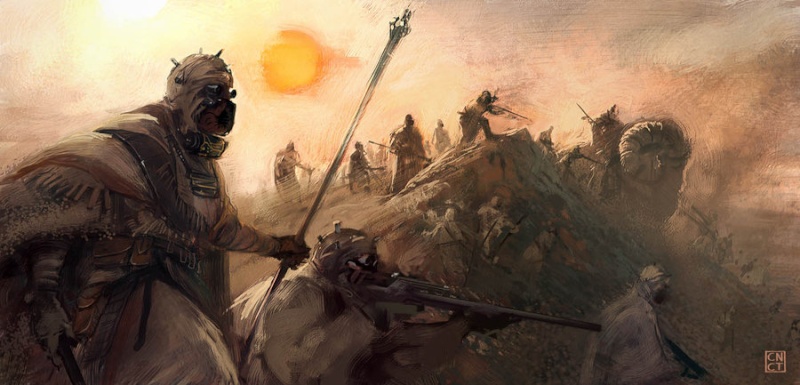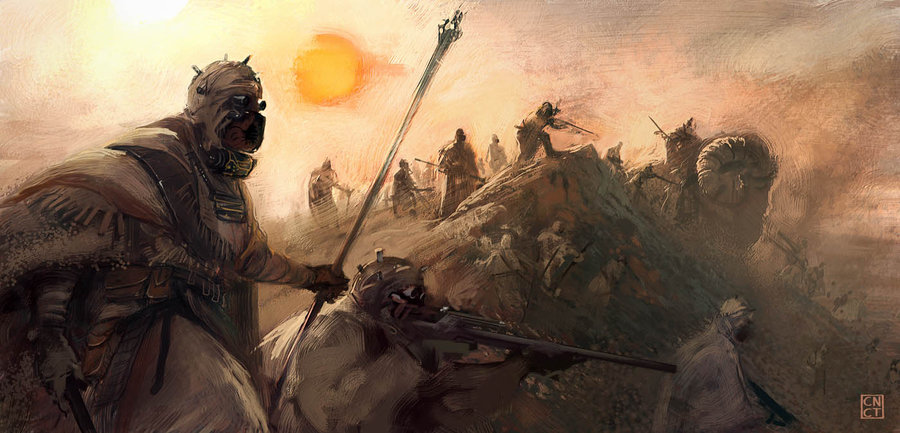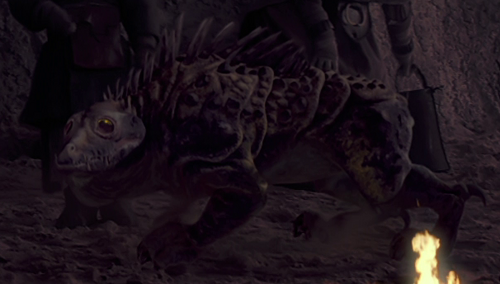- Joined
- Feb 13, 2012
- Messages
- 8,728
- Reaction score
- 5,318

Kuar Clan
Found on the so-called 'frontier world' of Tatooine the Kuar Clan is a group of Tusken Raiders. Occupying a region just north of the Jutland Wastes, where they have nomadically lived since the construction of Mos Eisley by the ruthless Czerka Corporation, the Kuar have, like many of their kin, faced centuries of turmoil, in a galaxy that is infringing more and more on their ancestral lands.
Culture
Native to the desert world of Tatooine, a land of few resources and little by way of friendly flora and fauna, the Kuar life has been one of survival. Increasingly territorial, seeking to lock down and control their limited natural resources mercilessly, they have a proud tradition of raiding, which they see as part of their way of life against the outsider. Like all Tusken Raiders, they hold Tatooines limited water supplies as sacred, believing that it was promised to them by their pantheonic Gods. In the case of the Kuar, it is this belief that drives their penchant for violence, especially toward Moisture Farms and other settlements.
The Kuar are a nomadic people, moving from place to place in pursuit of food and resources. Mostly, they do on their historic land, near the Needles Region of Tatooine. At present, the Clan is made up of roughly thirty Members and is lead by a Chieftain. Kuar places huge importance on the massiffs, a type of hound, that is seen as an important beast - indeed, the God 'Massiffi', being the patron of the Clan, commands them (according to ancient legend) to ensure each member of the Clan has at least one trained Massiff throughout their life.
Warlike, like most if not all of the Tusken Clans on Tatooine, the Kuar are a nomadic people - making camp only when needed, and often only for as long as the hunting season continues. Making use of gaderffii sticks and more recently and cycler rifles, Kuar members adorn themselves in the traditional garments of their species. However, they are known to decorate their armour with bones, normally taken from their victims.
The Bantha has a close bond with members of the Kuar, something that is shared across the Tusken species - with young Kuar being paired with a Bantha of their gender at an Inititation Ceremony, and is expected to care for, and ride the Bantha for as long as it lives. Bantha are treasured beasts in the Tusken culture, and for that reason are never hunted - and it is not uncommon for a Tusken who loses their Bantha in combat or through poor care, to take their own life, or go into exile if they cannot pair with another by the end of the season.
More nomadic than most of their kin, the Kuar are almost constantly on the move - very rarely visiting the Needles Region except for in the most dire of sandstorm seasons. To that end, they consider their territory to be the immediate area around their camp only, and are as such not above raiding more adventurously than their peers. In keeping with tradition however, the Kuar do maintain a small sect or social caste of Storytellers and Shamans - on account that Tusken cannot read or write, and a few are born with seemingly mystical powers.
Storytellers form a key segment of the Tribe, and the incumbent tellers are often very close to the Clan Chief, orally learning the tales of their ancestry with perfect accuracy. This tradition was such a large part of Tusken culture that Storytellers were considered the most important members of a tribe. It is considered a grave crime for a teller to incorrectly tell, or to forget the oral and spoken history of the Tusken people.
Shamans oversee the Tusken Rituals, the most important being the bloodrite, in which a Tusken 'comes of age' - by killing one of Tatooines many predators, on their own, and bringing back a part of its hide.
History
Historians have long since give up trying to work out when and where the Kuar Clan came into being, with most people just pencilling it down in studies as 'a long time before Czerka got here'. Suffice it to say, thanks to the merits of not having a written history (or even a written language), much of their distant past has become the work of storytellers, who widely agree that the Clan was founded by the son of the Tusken God, the sons name being Kuar. Storytellers will wax lyrical about how many monsters Kuar killed, and how much great fame he accumulated in the process, but most historians see little actual factual basis for this.
In more recent, documentable history, the Kuar have mostly been doing what one would expect of a tribe of Tuskens, engaging in raids and other such practices, more commonly against The Czerka Corporation and the ever growing factions of the Sith Empire. Indeed, on more than on occassions, there have been fragmented reports of the Clan working with (and that term is used very loosely) Rebellion Groups on Tatooine, presumably assuming that the enemy of ones enemy, is ones friend.
Intent
This will be a small RP group, focused on PvE and PvP almost entirely on Tatooine. Built around a few player characters, the Tribe will attempt to build its influence and importance on the planet, hopefully becoming the bogiemen of the world in good time. From this, I hope lore articles will be done by members, with plots and fun to follow.
Current Interest
Currently we have interest from Nor'baal, Monsi, Nommie and Rimrald to make Tusken Warriors for the group.
[/FONT]
Last edited:








